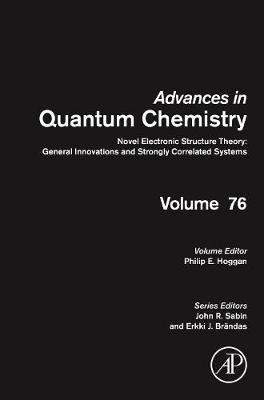
Novel Electronic Structure Theory: General Innovations and Strongly Correlated Systems
Academic Press Inc (Verlag)
978-0-12-813002-5 (ISBN)
Numerical Hartree-Fock and Many-Body Calculations for Diatomic Molecules, and more.
Born in Aberystwyth, Wales and educated at Trinity College Cambridge, Philip Hoggan has always been French and British. After a mathematical chemistry background, he has studied a number of theoretical systems, with a DSc by research obtained in 1991 at Nancy, France on the way physical interaction between molecules and solid surfaces is a precursor to catalysis. This was treated entirely on the basis of Quantum Mechanics and applied, first to cis-trans butadiene isomerization on alumina and then a number of ‘organic’ reactions. The first lectureship was at Caen, Normandy from 1992. This period led to some fundamental research of ab initio Slater electronic structure calculations for more than 3 atoms. The first related code STOP was published in February 1996 after much work by a postdoctoral fellow A. Bouferguène, now Professor at U Alberta. After continuing to study catalytic systems at Caen, from a theoretical viewpoint, Philip Hoggan was appointed to the Chair of Theoretical Chemistry in Clermont from May 1998. This is still essentially his teaching position, although research interests have switched to solid-state (surface) physics joining the Pascal Institute for physics in Clermont from 2005. This followed a visiting professor stay of 18 months at Tallahassee, Florida in Theoretical Physics. Research emphasis has shifted from the STOP era (where the problem was solved by Coulomb Resolution in 2008) to Quantum Monte Carlo (QMC). The CNRS paid leave for a couple of years for Philip Hoggan to learn about this technique from Cyrus Umrigar, Julien Toulouse, Michel Caffarel and others. Of course, it eventually led to a project to calculate catalytic reactions on metal surfaces that was initiated by G-J Kroes (Leiden, NL) and his ERC in 2014. K Doblhoff-Dier arrived in Clermont for a ground-breaking research fellowship and each of us continues to produce very accurate work e.g. on hydrogen (production and dissociation on metals), as a clean fuel for renewable energy. Now, in 2023 we enter the 400th anniversary of Blaise Pascal’s birth. He invented calculators, some of which are in the Clermont museum. It is wonderful to work in the institute that bears his name conducting QMC on catalytic hydrogen synthesis on super-calculators: the tools that trace their roots to his ‘Pascaline’. Philip Hoggan is married and has twin daughters.
Section I: Molecular Electronic Structure Methodology and Reviews 1. Present Status of Selected Configuration Interaction with Truncation Energy Error 2. Recent Developments in Asymptotic Expansions from Numerical Analysis and Approximation Theory 3. The Kinetic Energy Pauli Enhancement Factor and Its Role in Determining the Shell Structure of Atoms and Molecules 4. On the Laguerre Representation of Coulomb Functions and the Relation to Orthogonal Polynomials 5. Numerical Hartree–Fock and Many-Body Calculations for Diatomic Molecules 6. Local Effective Hartree–Fock Potentials Obtained by the Depurated Inversion Method 7. 4-Center STO Interelectron Repulsion Integrals with Coulomb Sturmians 8. Recurrence Relations for Four-Electron Integrals Over Gaussian Basis Functions 9. Ab Initio Molecular Local Nuclear Magnetic Shielding Tensors
Section II: Electron Correlation in Atomic Systems 10. Atomic Electronic Structure Computations with Hylleraas-CI Wave Functions 11. One-Particle Effective Potential for Helium Atom 12. Configuration Interaction Study of the 3P Ground State of the Carbon Atom
Section III: Strong Correlation in Electronic Systems 13. Extension of the Configuration Interaction Monte Carlo Method to Atoms and Molecules 14. Time-Dependent Linear-Response Variational Monte Carlo 15. Quantum Monte Carlo Calculations for Industrial Catalysts: Accurately Evaluating the H2 Dissociation Reaction Barrier on Pt(111) 16. Density-Based Analysis of Spin-Resolved MP2 Method 17. Time-Dependent Configuration Interaction Using the Graphical Unitary Group Approach: Nonlinear Electric Properties 18. Hybrid Treatments Based on Determinant Seniority Numbers and Spatial Excitation Levels in the Configuration Interaction Framework 19. Potential Energy Curves for the LiK+ and NaK+ Molecular Ions with the Coupled Cluster Method
| Erscheinungsdatum | 16.01.2018 |
|---|---|
| Reihe/Serie | Advances in Quantum Chemistry |
| Verlagsort | San Diego |
| Sprache | englisch |
| Maße | 152 x 229 mm |
| Gewicht | 750 g |
| Themenwelt | Naturwissenschaften ► Chemie ► Physikalische Chemie |
| Naturwissenschaften ► Physik / Astronomie ► Angewandte Physik | |
| ISBN-10 | 0-12-813002-4 / 0128130024 |
| ISBN-13 | 978-0-12-813002-5 / 9780128130025 |
| Zustand | Neuware |
| Haben Sie eine Frage zum Produkt? |
aus dem Bereich


